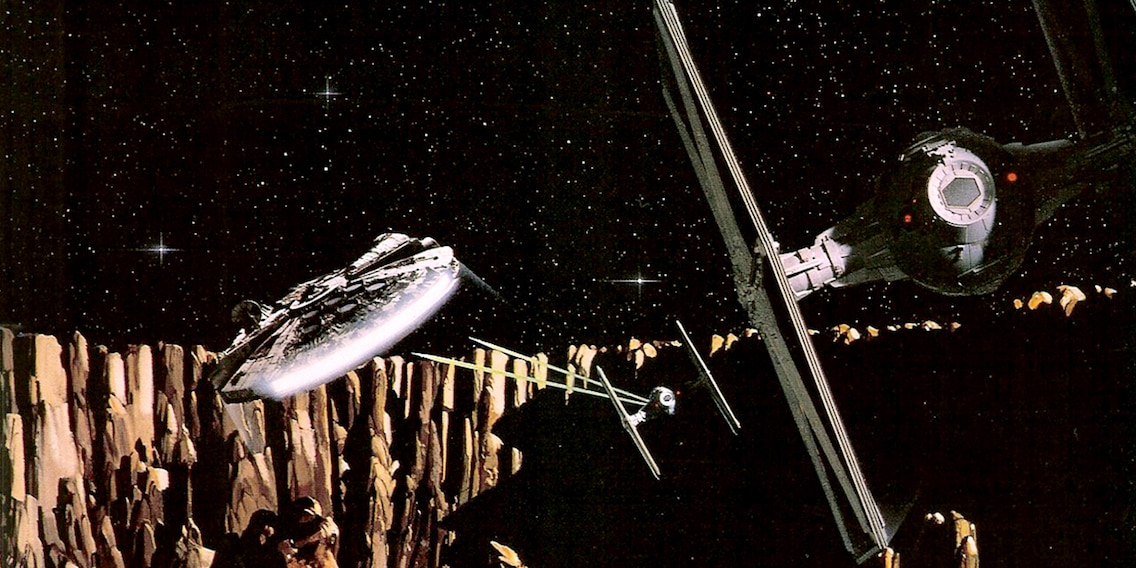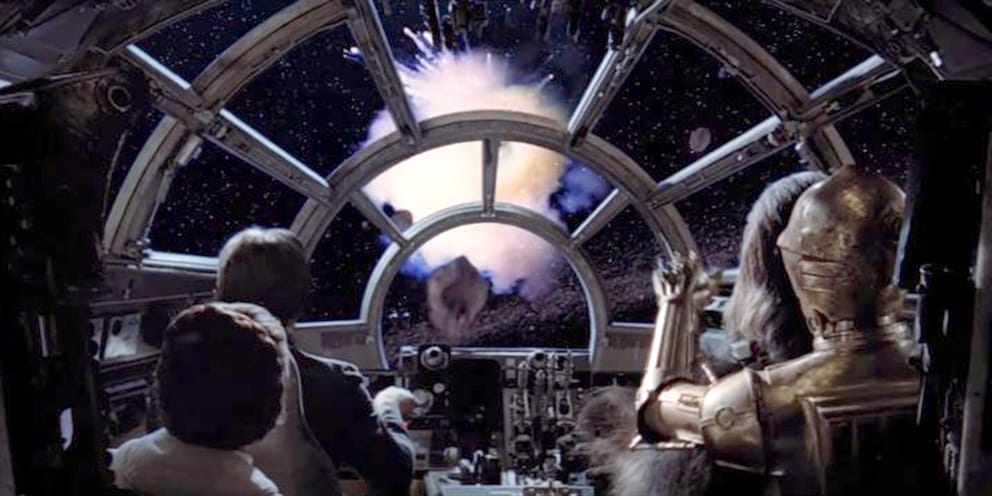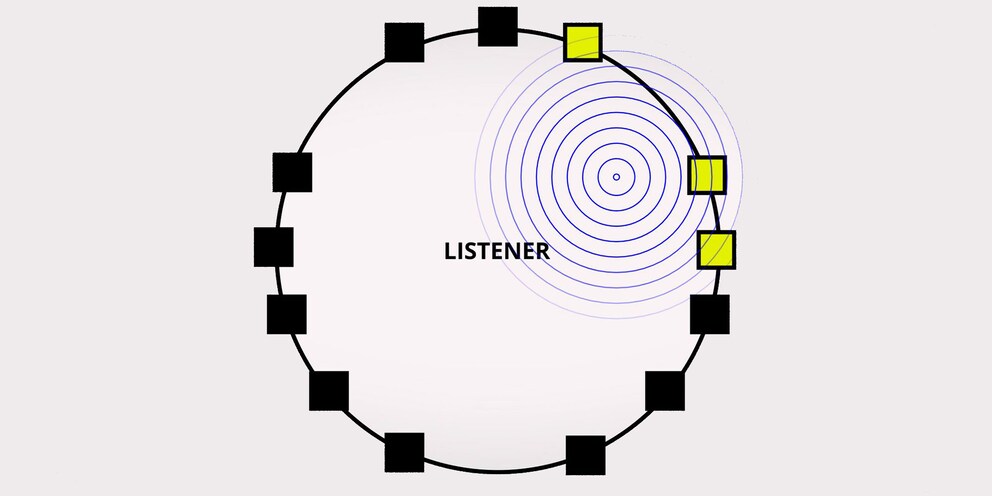
Dolby Atmos and why it’s the next cinema revolution

5.2.2018
Revision: Eva Francis
Maybe you’ve already heard of Dolby Surround. But what about Dolby Atmos? Let me try to explain using one of the most exciting and revolutionary chase scenes in cinema history as an example.
The power cells on the TIE fighters – deadly starfighters from the imperial fleet in «Star Wars» – screech when they go off in pursuit with an ear-splitting sound. The Millenium Falcon skillfully evades every bullet, and the laser beams miss the modified cargo ship by a whisker. With a crazy manoeuvre, the Falcon skirts the asteroids. The outer shells groan in protest when they come up against power beyond description that threatens to tear the ship apart.
«They’re not flying straight into the asteroid field, are they?» asked Leia Organa, confused.
«They’d be mad to follow us in,» replied Han Solo, the fearless smuggler. In this moment, he wondered if he really was quite so fearless.
Cue chase scene that will go down in cinema history for its revolutionary computer effects and clever dialogue.
I know I’m not telling you anything new when I say you need a humming base and two to five speakers around you like a sound dome to feel like you’re in the middle of an absurd chase. And if I had my way, it would also come with 3D effects, lots of popcorn and a bunch of «bang, bang, bangs».
But hey, each to their own.
Cinema sound
At the cinema, popcorn, «bang, bangs» and torrents of words are what we’ve all come to expect – in terms of sound, at least. That’s all brought to us by Dolby Surround, technology for surround sound. Dolby Surround was developed by Dolby audio specialists.
The company dominated the cinema landscape for years with their digital standard «Dolby Digital». The best-known competitor format is DTS (Digital Theater Systems), but it has actually been a Californian company that made the most progress in digital multi-channel audio format in the last few years.
The name gives it away. Dolby Surround ensures you hear each and every sound exactly where the director or sound editor wanted you to. Like the waterfall in Apocalypto that thunders over you and makes you check instinctively to see if you’ve been hit by any splashes.
Check out the waterfall 0:27 minutes in
Or a laser beam that only just misses you and crashes into the living room wall behind you with a «bang, bang».
Maybe I’m taking it too far, but you know what I mean.
A mini revolution has been going on since 2012. More and more cinemas are being upgraded – specifically, with upgrades that include Dolby Atmos. This is another example of technology that makes you feel like you’ve got sound thundering all around you. In other words, surround sound.
With headphones on, you really notice the surround sound effect
But here’s where it gets interesting…
Dolby Atmos goes a step further:
- There is practically no limit on the number of loudspeakers, which gives a real feeling of surround sound.
- At first, the sound also comes from above – something that gives a completely new sound experience.
- The sound consists of two main elements: base sound and dynamic audio objects.
- Dynamic audio objects move on a precise path in surround sound.
Was all of that too cryptic? OK, let’s go through it one by one.
Dolby and digital standard Dolby Surround
… the chase continues.
«They don’t have to do that to impress me,» protested Leia.
C3PO, the golden droid, agreed and exclaimed with a panic-stricken voice, «Sir! The possibility of successfully navigating an asteroid field is approximately 3,720 to 1!»
«Never tell me the odds,» interrupted Han.
Meanwhile, a straying rock fragment smashes into a TIE starfighter, whose pitiful pilot couldn’t avoid the approaching asteroid in time...
Dolby Surround 5.1, 7.1 and… what was that?
To make it sound like a space freighter really is gliding through an asteroid field in your living room, you need at least five speakers and a subwoofer. You’ll need to position three of the speakers in front of you (left, right and in the middle above the picture) and put the other two behind you (again, left and right). The subwoofer delivers the bass. Numerically speaking, five speakers and one subwoofer means 5.1. If you add two more side speakers, you’ve got yourself a 7.1 system.
Above, you can see an example of a 5.1 system with three loudspeakers in front, two behind and a subwoofer for the bass. Add two more speakers and you’ve got a 7.1 system.
Sound is channel-specific
Channel-specific is a phrase you’re going to hear a lot. Why? Because each speaker has its own channel. If I was a sound editor in Hollywood, I’d be responsible for making sure every sound in the film, from music to dialogue as well as sounds and other audio effects, was allocated to the right channel.
This is a way to imagine it in more visual terms. When the starfighter on the telly slams into an asteroid at breakneck speed to your front right and explodes into thousands of pieces, the deafening explosion is transmitted across the channel that leads to the front right loudspeaker. That sounds pretty logical, doesn’t it?
We can obviously take this even further.
Imagine the aforementioned fighter spinning over your shoulder and across the picture, or rather crashing. This is how the sound mixing works: The whining sound of the engines is relaid at full volume to the back left. The whining sound at the back left then gets progressively more faint. All the while, it gets louder and louder at the front right. The sound then spills over from one speaker to another. As a listener, you’re made to believe the starfighter and its howling noise have moved from back left to front right:
The TIE fighter starts from behind you, flies over your shoulder and straight into its path of destruction.
Yay! We’ve got surround sound.
Dolby Atmos: three steps away from the next revolution in cinema
Back in the chase… the staggering collision of two huge asteroids almost signals the premature end of the Falcon. Han knows that only sheer luck saved the crew from the grasps of death. Debris bashes loudly and menacingly against the outer walls of the Falcon.
«Oh no,» screamed C3PO, panic-stricken.
«You wanted to come along, if I’m not mistaken,» said Han sullenly to Leia, who was still smarting from his arrogant know-it-all behaviour. «This is it.»
«I take it all back,» she replied coarsely.
Step 1: unlimited surround sound
Dolby Surround is about finding the right sound mixing and transmitting across one channel. Dolby Atmos almost flips this concept on its head.
In cinemas, a 7.1 surround system is standard. To clarify, 7.1 refers to a sound mix with seven audio channels plus bass. Dolby Atmos doesn’t work with these kind of parameters. Theoretically speaking, you could even use an unlimited number of soundtracks. As cinemas don’t have endless space for speakers, the mix is usually limited to 64 different loudspeaker signals.
As always, that’s underplaying it in a big way.
This number of speakers lets you build a kind of sound dome or acoustic space around the viewer.
Step 2: sound from above
For the first time, cinemas are getting a new sound dimension thanks to Dolby Atmos, namely sound from above. It’s shocking. But when you think that in the real world, we get audio signals from all directions – and not just back and front, left and right – the concept of sound coming from the ceiling really is revolutionary. No matter what our hearing is used to, we’re not trained for sounds coming from above in the cinema. And that’s what makes this development so exciting.
Just imagine the menacing crackle of an activated lightsabre sweeping over your head. Or the debris and outer casing of the spaceship constantly trying to take your life. Because the sound comes from above, you won’t be able to help looking up nervously. The real thrill is the new sound feeling. Dolby like to dub it the sound of God in their marketing material.
As you can see, the number of speakers isn’t the only reason the acoustic space of an Atmos system is superior to that of a surround system. It’s more a case of the different dimension that funnels sound down from above. It’s perfect for that moment when the swooshing in the branches in the forest moon of Endor announces the breakneck incline of one of the swinging vine ewoks.
I can even hear the ewok screaming in my ears.
Step 3: dynamic audio objects
Believe it or not, the best is yet to come. No longer will all sounds be directed along one channel. Instead, things that move – like the frantic Falcon, Hans’s space freighter and the faltering TIE starfighters – will be classed as simulated objects within this sound dome. Dolby also refers to them as dynamic audio objects. Thanks to the latest algorithms, these audio objects can be positioned precisely in the room. It depends where they are as to which speaker is activated. It looks a bit like this:
Source: Techquickie
In real time, Dolby Atmos technology algorithms calculate which speaker has to be activated at what volume to simulate the moving object correctly. Isn’t that clever?
Dynamic audio objects in surround sound
At the same time, at the other side of the galaxy, Luke Skywalker, son of the legendary warrior Anakin Skywalker, is starting his Jedi training. On the rough, inhospitable swamp-ridden planet of Dagobah, he unwillingly sunk his X-wings as instructed by Yoda, the wise and powerful Jedi master of days gone by.
«Adventure. Excitement. A Jedi craves not these things» said the master to his student reproachfully.
Nothing about his delicate appearance points to the immense power within Yoda. The small creature raised his hand and, as if by magic, Luke’s X-wings raised up from the depths of the swamp...
This is how Dolby Atmos works
A finished Atmos mixdown comprises a base of background noises. These are built up using Dolby Suround’s channel-based process. In the chase scene we keep coming back to, the humming of the Falcon machinery would be a typical background noise. Other examples include rain on the hideous planet of Dagobah, which pitter-patters relentlessly on Yoda’s little hut. In both examples, the sound surrounds you. It’s somehow always there without really moving.
«Will he finish what he begins?» – Yoda
Dynamic audio objects accompany the background noises. This means any sounds or noises that move and aren’t static. Typical dynamic audio objects would be: Yoda’s voice when he’s speaking to Luke off screen and then when he joins his student. Or Luke’s X-wings when Yoda lifts it up and out of the dirty swamp.
Without delving unnecessarily deep into the subject, it’s clear that dynamic audio objects consist of two main points. Firstly, the sound itself and also the position information, known as metadata. This lets you pinpoint the object in the room. To give you an exact reference point – in other words, if it’s left of you or diagonally to the right in front of you – each of the objects is linked up to a motion vector.
This means that while you’re sitting there and watching as Han achieves what seemed an impossible manoeuvre to trap the bad TIE fighter pilots, there are dynamic audio objects moving around you as though in a dome.
That’s pretty cool.
«Size doesn’t mean anything,» said Yoda in his wise, deep voice that didn’t seem to fit with his measly frame. «Look at me. Judge me by my size, do you?»
Luke averted his gaze ashamedly, but Yoda didn’t let up.
«And well, you should not. For my ally is the force and what a powerful ally it is.»
The main advantage over Dolby Surround
The advantage of one technology over another doesn’t help much if it’s not user-friendly or isn’t backward-compatible. At Dolby Surround, the sound editor has to factor in the exact number of channels. For example, on a 7.1 mix, they might want the chirruping, tweeting and clicking sounds of the extraterrestrial birds native to the planet Dagobah to play on the side speakers at viewer height.
And yet, if you watch the 7.1-mixdown film on a 5.1 system, the sound will just be fed to the back two speakers. In other words, the sound experience the sound editor envisioned will be distorted. This leaves them with no option than to create two different mixdowns. There is no alternative way of getting the balanced background noise in both cases as the director or sound editor intended it.
However, when it comes to Atmos, this is totally different. Only one mixdown is needed. It doesn’t matter if there are five, seven or even 64 speakers in the system. It goes without saying that the more speakers there are, the better the sound will be, as it allows for more precise positioning of moving objects. Nevertheless, a modern algorithm independently works out (in real time) which speaker it has to activate.
It’s not just sound editors and audio geeks that can get a kick out of this. It’s something for you, too. Why? I can tell you in just two words: home cinema...
In fact, that sounds like a good topic for the next article. Don’t you think?
The end of the chase
Light years away, the chase scene in the asteroid field comes to a head. For the last time, Han Solo flies the careering Falcon suicidally through what seems to be a too small crevice on the surface of an asteroid.
«That’s suicide,» complained C3PO.
The TIE starfighters, who are still trying to zap the freighter with deathly laser shots overestimate their own maneuverability and end up bursting into flames. For the moment at least, Han has managed to get rid of his pursuers.
«That doesn’t look too bad,» he said, referring to an underground cave. «We could hide in there.» With a deft maneuver, the smuggler steers the Millenium Falcon straight in.
«I hope you know what you’re doing,» whispered Leia with uncertainty.
Han retorted with more concern in his voice than he’d have liked. «Yes, me too.»
No one had an inkling they were flying straight into the jaws of a huge outer space worm.


Luca Fontana
Senior Editor
luca.fontana@digitecgalaxus.chI'm an outdoorsy guy and enjoy sports that push me to the limit – now that’s what I call comfort zone! But I'm also about curling up in an armchair with books about ugly intrigue and sinister kingkillers. Being an avid cinema-goer, I’ve been known to rave about film scores for hours on end. I’ve always wanted to say: «I am Groot.»
Audio
Follow topics and stay updated on your areas of interest
Movies and series
Follow topics and stay updated on your areas of interest










